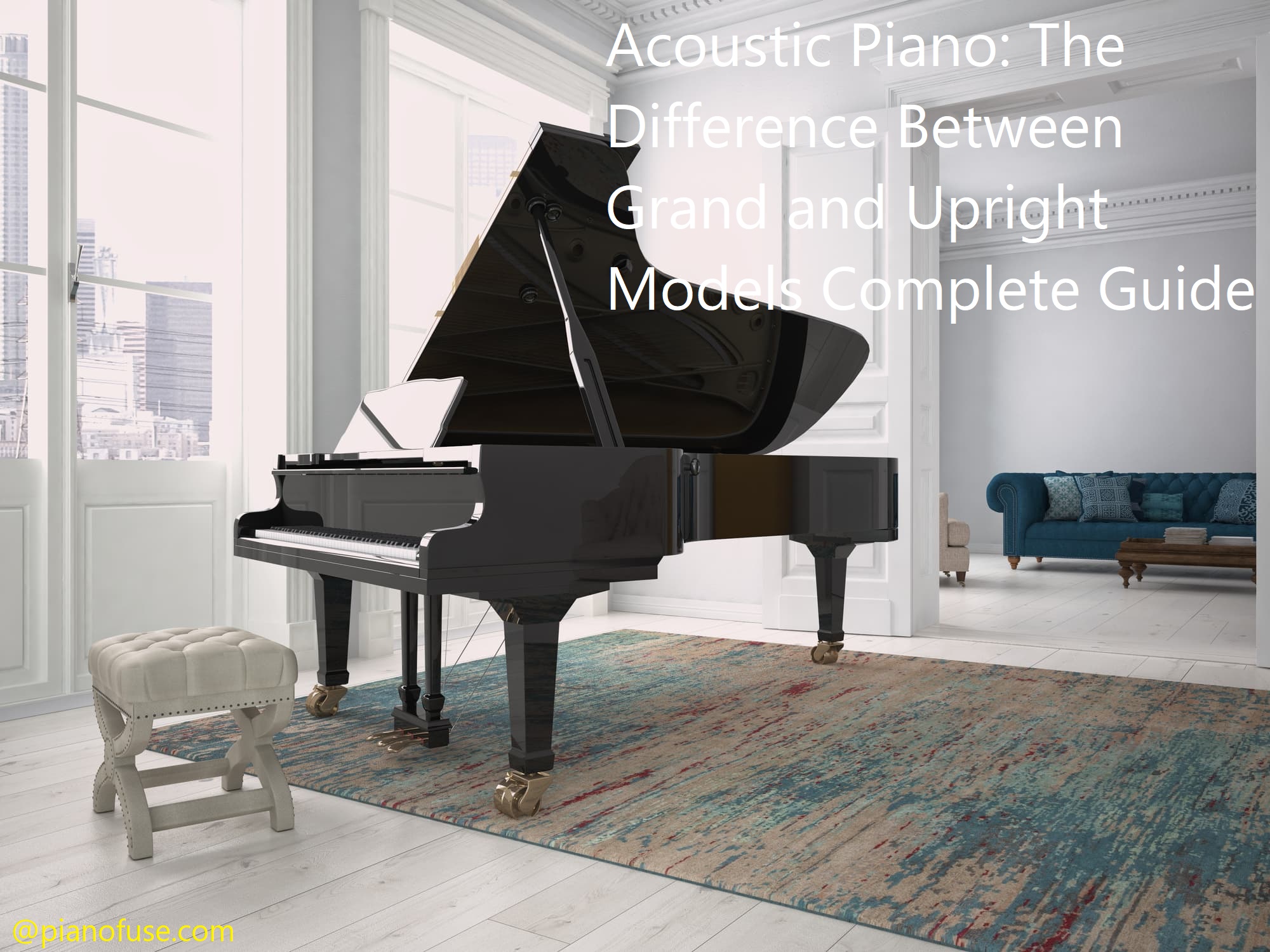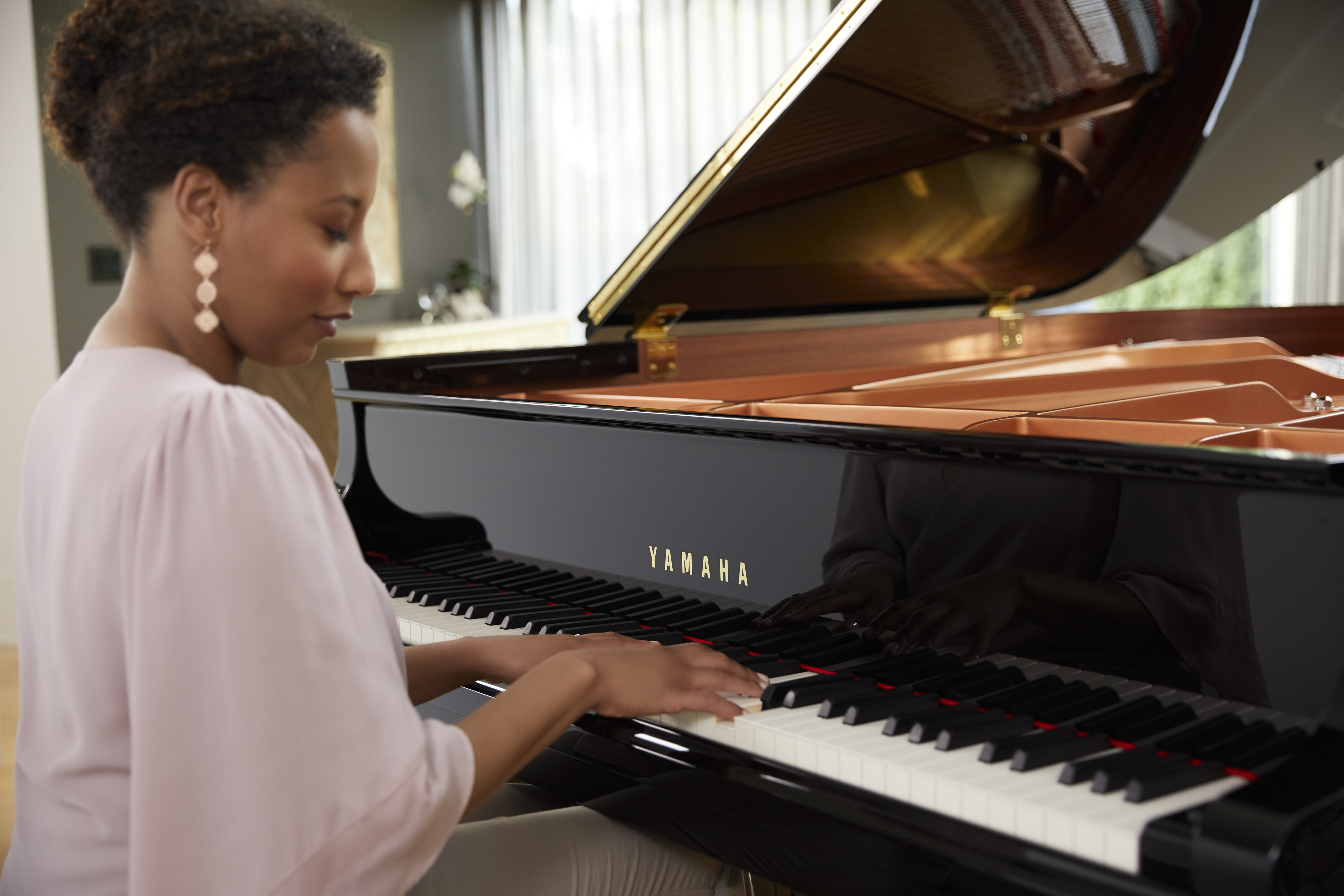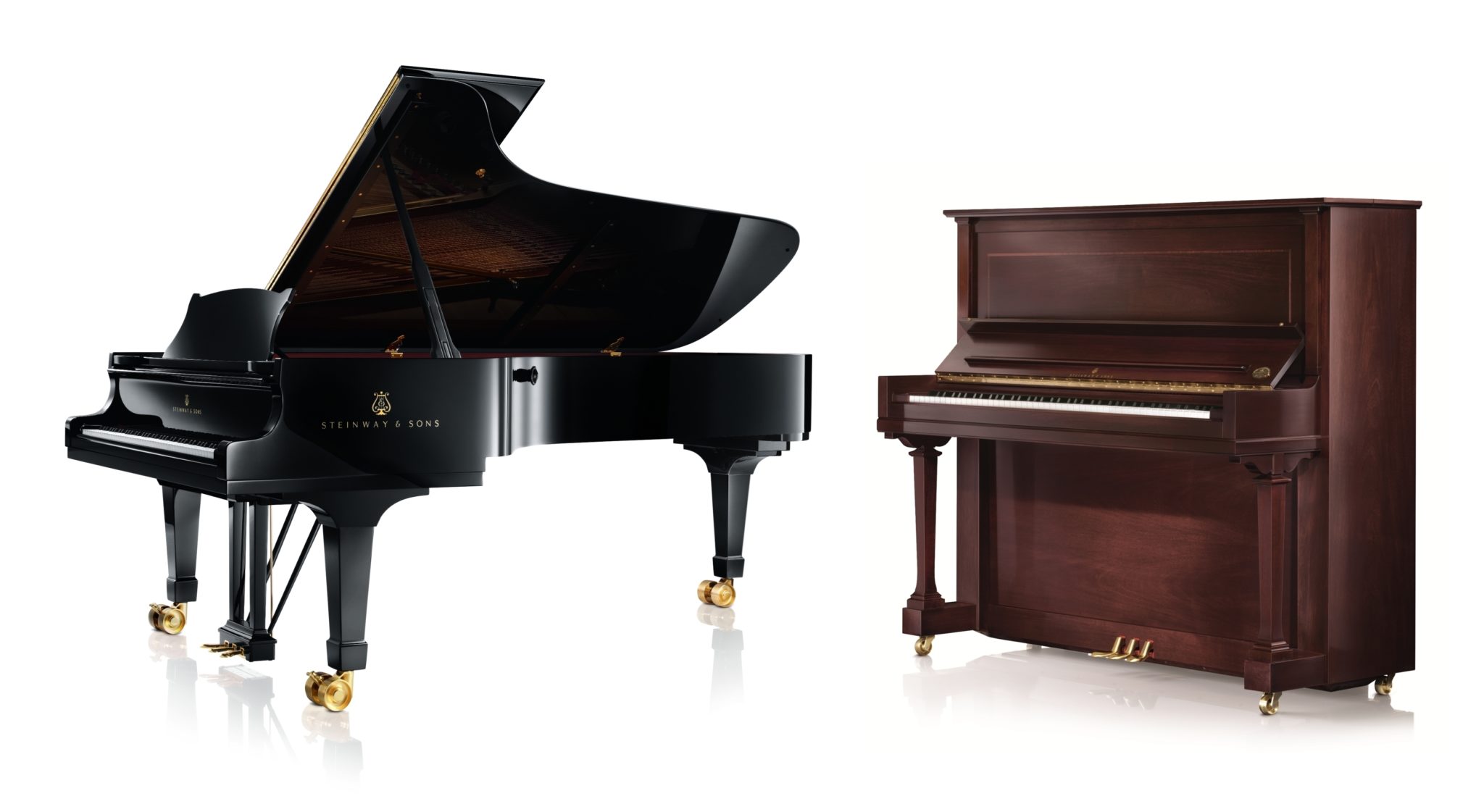Are you wondering which type of acoustic piano is perfect for you?
Grand pianos are often praised for their luxurious sound, but can be quite expensive. Upright pianos provide a more affordable alternative with a smaller footprint. This guide will help you decide between grand and upright models. You’ll learn the differences between the two, what to consider when purchasing one, and why acoustic pianos are worth investing in.
The acoustic piano is one of the most iconic and beloved instruments of all time, with a long and fascinating history. In its simplest form, the acoustic piano consists of a frame, an exterior case, strings, hammers and keys. As technology has advanced over time, however, these components have become more complex and varied. This has led to the existence of two principal types of pianos – grand pianos and upright pianos – each with its own unique set of characteristics and features.
In this guide we’ll explore the various components that make up each type of piano, looking at acoustic design differences as well as how they differ in size, sound quality and price range. We will also analyse how this affects the choice between them when choosing an ideal model for one’s needs. Ultimately you should be able to discern which model best fits your own particular requirements after reading this guide.
Explanation of the topic
The two main types of acoustic pianos are grand pianos and upright pianos. Both provide an acoustic sound and are preferred by many musicians due to their warm, even tone and responsiveness to touch. The type of piano that you choose will depend on your preference, budget, and space available. Grand pianos are typically larger than upright models and offer a range of features that may be worth the expense for some buyers. Upright pianos tend to be more affordable than grand ones, making them perfect for small spaces or budgets that can’t accommodate a grand piano.
To make an informed decision when selecting either a grand or upright piano, it is important to understand the differences between them both in terms of size, sound production, appearance and cost. This guide explains the key differences between grand and upright pianos so you can decide which model is best suited to your needs.

Importance of understanding the difference between grand and upright pianos
It is important for budding pianists to understand the key differences between grand and upright pianos in order to make an informed decision when selecting a piano. Upright pianos tend to be more affordable than grands of the same quality, but they also have some important limitations.
Grand pianos have longer strings, and therefore generate greater sound pressure levels. Their size allows them to sustain tones much better than an upright piano and they produce a richer bass tone. Upright models offer less control over string dynamics, while grand pianos allow the player more control because of their greater resonance.
The action of a grand model is usually slightly lighter than that of an upright meaning they require less force or effort to play complex pieces with advanced articulations. Grand pianos also come in different sizes with different sound qualities, so it’s good to try them before buying one so you can get used to the response and what works for you best. Upright models don’t typically come in various sizes – rather those that are available are adjusted aesthetically by changing the molding around their base or casing which doesn’t actually affect their sound quality or capabilities.
Acoustic Piano Basics
It is important to have a basic understanding of the different kinds of pianos before choosing one for your home. There are two main types of acoustic piano: grand and upright models. Both styles come in a variety of sizes, but there are some clear distinctions between them. Here is an overview of the key differences between grand and upright pianos:
Size: Grand pianos are typically larger than vertical models, with a longer and wider soundboard, which helps to produce a richer, fuller sound. They also have an extended range compared to upright models because their strings can be longer due to their size. Upright pianos tend to take up much less space than grand pianos; they may be ideal if you’re trying to save floor space.
Sound Quality: Grand pianos generally have better sound quality than upright models because the strings and soundboard produce more resonance due to their larger size. The added expression that comes with playing a grand piano makes it a favorite among professional musicians. Upright models tend to be smaller in size and cost, which can make them more appealing if you’re looking for an entry-level instrument or one that can work well in small spaces.
Weight: Grand pianos are typically heavier than vertical ones; some large grand pianos can weigh up to 1,000 pounds or more! Upright versions tend to weigh significantly less due to their size, making them easier for you or your movers carry around should the need arise.
Price Range: In general, grand pianos tend to cost more than vertical ones; however, there are price variations depending on the brand or model you purchase — as well as if it has been used previously (as is often the case). Generally speaking, if budget isn’t an issue buying a new model from an established brand is recommended—and researching and consulting professionals at specialty stores like Bright Piano Company may help guide you when purchasing either type of piano.
Explanation of the acoustic piano
An acoustic piano is one that is played by pressing keys on the keyboard which cause small hammers to strike the steel strings within the instrument. The piano also has a set of damper pedals that are operated by the pianist’s feet and are used to lift and lower small dampers inside of the instrument. This creates a fuller sound and allows for more nuance in playing. The strings in an acoustic piano can vary from around 88 up to 102, depending upon the model. This means that some models offer a wider range than their counterparts and can offer a different feel when playing.
Acoustic pianos typically come in two main models; grand pianos and upright pianos. Generally speaking, grand pianos are larger instruments with longer strings and thus produce a fuller, richer sound which makes them preferred for concert halls or music recording studios due to their expansive dynamic range, while upright pianos are smaller instruments that are better suited for personal or home use due to their space-saving design and relative affordability.
Components of an acoustic piano
Acoustic pianos use a very complex set of mechanical components to create a beautiful sound. Let’s take a close look at what is inside an acoustic piano.
The Strings: Every acoustic piano contains about 230 strings tuned to specific notes and controlled by different mechanisms. Each string is attached to two felt hammers that strike the string to produce sound vibrations. The strings range from short treble strings up to longer bass strings.
The Soundboards: The soundboard provides the amplification for the instrument, so both grand and upright models will have similar-shaped soundboards with ribs and other reinforcements designed for optimal sound production. Upright pianos usually have one large board, while grand pianos will usually have two boards, split down the middle by the curved shape of the instrument’s body.
The Action: The action includes many complex mechanical parts that move when keys are played and transfer energy from your fingers through a series of levers and pivots. The most important part of this system is the hammer assembly which consists of several interconnected parts that regulate how quickly or slowly they will transfer motion from keystrokes in order to produce a desired level of loudness or softness in the note being played.
The Cabinet: Grand pianos are generally housed in slim rather than bulky cabinets made out of fine hardwoods, with decorative accents on either side panels or on legs at both ends. Upright pianos tend to have larger cabinets constructed from MDF (medium density fiberboard) which are designed more for stability than esthetic beauty and room decoration.
Grand Pianos
Grand pianos are large, rectangular-shaped instruments that produce a sonic experience unlike any other piano. Named for their expansive size, grand pianos use gravity to transmit sound as opposed to upright designs which rely on small metal or plastic hammers positioned perpendicular to the soundboard.
A true grand piano consists of three main parts: the strings, a wooden frame containing metal strings and felt-covered hammers aligned above them; the action, which is comprised of over 8,000 individual components that transfer motion from the keyboard when a key is pressed; and the soundboard, a wooden structure whose vibrations amplify the timbre of each note struck. The larger size affords both a longer sustaining tone for each note struck but also greater projection and increased electrical sensitivity for recording purposes.
Grand pianos can range in size from extremely small (known as parlor grands) to extra large (a concert grand). Depending on its size and design, acoustically speaking they may heighten treble tones or warm bass tones. Additionally, they can be more “touch sensitive” than their upright counterparts meaning they will respond more dynamically with variations in touch/pressure/technique used by students as they learn to play and progress musically. Grand pianos also normally utilize firmer action materials than upright models and require less frequent regulation maintenance due to their design utilizing more wood multiplex parts instead of plastics found on an upright action assembly – meaning grand piano actions tend to remain quite playable much longer between regulation maintenance periods.

Definition and explanation of grand pianos
Grand pianos are widely considered the pinnacle of piano design. Their power and versatility makes them the instrument of choice for professional musicians, live performances, and recordings. Grand pianos have a larger soundboard than the average upright piano and this helps to amplify the resonance produced by each note. They are also built with three pedals, whereas uprights typically have two. The pedals extend the dynamic range of they keyboard and offer more tonal experimentations with different voicing techniques.
Grand pianos are constructed in two shapes – “concert” grand which is much larger (often 9 feet or longer) and intended for theatre stages or concert venues; “baby” grand which often measure anywhere from 4-7 feet in length and more commonly used at home or in other more intimate settings. The hammers on a grand piano are able to move more freely than those of an upright so that there is less strength required to press a key down for an extended length of time which is important for performing long passages where one hand might be played exclusively.
The action inside a grand piano also allows for greater responsiveness from the time your fingers touch the keys until you hear that first note, resulting in a performance that feels almost instantaneous – allowing each performance room to have its own unique sound.
Types of grand pianos
Grand pianos come in two main categories — baby and full. Baby grand pianos are generally five to six feet in length while full grand pianos are seven to nine feet. Of course, there are some exceptions as some manufacturers specialize in ultra-short or long pianos as well.
Baby grand pianos take up less space and typically cost less than full sized grand varieties, but offer a sweeter sound and more powerful projection. The cabinet size of a baby grand also gives the instruments their distinctive shape, making it one of the most desirable household piano choices.
Full-size grands tend to offer richer bass tones, but still require more space than their smaller counterparts. Though they often cost substantially more than babies, they are renowned among musical professionals because their larger size creates a wide range of sound possibilities. Full-sized grands come with a variety of desirable features such as custom finishes and designs as well as quality materials like spruce soundboards and finely crafted key action systems.
Advantages of grand pianos
Grand pianos offer a number of advantages over upright pianos, particularly for players at the highest skill level. Grand pianos typically have higher-quality construction and a much larger soundboard and resonance area, which produces a more powerful sound. The strings in grand pianos also extend further from the hammers than in upright models, which favors the production of longer notes and provides a greater range of tonal nuances. This is why grand pianos are almost always used in classical concerts and recordings as well as any other music that demands a very nuanced performance.
Grand pianos also feature an action (the set of levers, hammers and dampers that govern the output of each key) laid out on two separate levels, giving it greater control over dynamics – changes in volume or intensity – combining both dexterity and power to great effect in complex passages. Additionally, the open strings in grand models provide excellent sustain; allowing notes to linger after being struck.
Despite their obvious advantages for professional players and performers, grand pianos come with their own inconveniences; they require far more room than standard uprights making them prohibitively large for many living-room spaces. Furthermore due to increased complexity of their design – it’s impossible for any ordinary person to move or transport one without advanced training – not to mention an extra pair of hands – making them entirely unsuitable if you like to change rooms regularly or if you’re planning on performing away from home at events or functions.

Conclusion
When considering the differences between an acoustic grand and an upright piano, it’s important to keep in mind your skill level and budget, as well as the size of space you have for the instrument.
Grand pianos are typically more expensive and take up a large amount of floor space, but they offer exceptional sound quality with far more control over your playing. Upright pianos are more affordable and can fit in spaces that grand models wouldn’t be able to.
No matter which option you choose, make sure to find a quality instrument that will last you years of enjoyment. Taking care of your piano is also extremely important—make sure to consult with a technician and invest in regular tuning to keep your investment sounding its best over the long haul.
FAQ’S
Which is better upright or grand piano acoustic?
Both upright and grand pianos have their strengths and weaknesses, and the choice between them depends on the player’s needs and preferences. Grand pianos typically have a more powerful and expressive sound, while upright pianos are more compact and affordable.
What is the difference between acoustic piano and grand piano?
An acoustic piano is any piano that uses hammers and strings to produce sound, while a grand piano is a type of acoustic piano that has a horizontal soundboard and strings.
Do upright pianos sound as good as grand pianos?
Upright pianos can sound just as good as grand pianos, but they typically have a more muted and compact sound due to their vertical soundboard.
What are the 3 types of pianos?
The three main types of pianos are grand pianos, upright pianos, and digital pianos.
Which piano has best sound quality?
The piano with the best sound quality is subjective and varies depending on the player’s preferences, but some popular options include Steinway, Bösendorfer, and Fazioli.
Which piano type is the best?
The best piano type depends on the player’s needs and preferences, but in general, grand pianos are considered to be the most prestigious and high-end, while upright pianos are more affordable and practical for home use.
What are the 3 types of upright pianos?
The three types of upright pianos are spinet, console, and studio pianos.
Are acoustic pianos good for beginners?
Acoustic pianos can be good for beginners, as they provide a more authentic and tactile playing experience, but they can be more expensive and require more maintenance than digital pianos.
Why are acoustic pianos so expensive?
Acoustic pianos are expensive because they are complex instruments that require high-quality materials and craftsmanship to produce a consistent and high-quality sound.
What are the benefits of an upright piano?
The benefits of an upright piano include a more compact size, affordability, and versatility in terms of placement and use in smaller spaces. They are also easier to maintain and repair than grand pianos.
See Also:
- Best piano mic 2023
- Best portable digital piano 2023
- Best portable piano keyboards 2023
- Best upright piano 2023
- Best yamaha digital piano 2023


